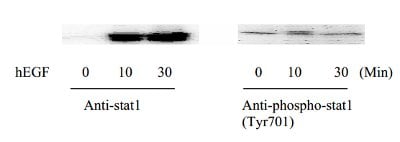STAT1 (Tyr701) In-Cell ELISA Kit (ab126426)
Key features and details
- Assay type: Cell-based (qualitative)
- Detection method: Colorimetric
- Sample type: Adherent cells
- Reacts with: Mouse, Human
Overview
-
Product name
STAT1 (Tyr701) In-Cell ELISA Kit
See all STAT1 kits -
Detection method
Colorimetric -
Sample type
Adherent cells -
Assay type
Cell-based (qualitative) -
Assay time
5h 10m -
Assay duration
Multiple steps standard assay -
Species reactivity
Reacts with: Mouse, Human -
Product overview
ab126426 is a very rapid, convenient and sensitive assay kit that can monitor the activation or function of important biological pathways in cells. It can be used for measuring the relative amount of STAT1 (Tyr701) phosphorylation and screening the effects of various treatments, inhibitors (such as siRNA or chemicals), or activators in cultured human and mouse cell lines. By determining STAT1 protein phosphorylation in your experimental model system, you can verify pathway activation in your cell lines without spending excess time and effort in preparing cell lysate and performing an analysis of Western Blot.
In the STAT1 (Tyr701) In-Cell ELISA Kit, cells are seeded into a 96 well tissue culture plate. The cells are fixed after various treatments, inhibitors or activators. After blocking, Anti-Phospho-STAT1 (Tyr701) or Anti-STAT1 (primary antibody) is pipetted into the wells and incubated. The wells are washed, and HRP-conjugated anti-mouse IgG (secondary antibody) is added to the wells. The wells are washed again, a TMB substrate solution is added to the wells and color develops in proportion to the amount of protein. The Stop Solution changes the color from blue to yellow, and the intensity of the color is measured at 450 nm.
-
Platform
Microplate
Properties
-
Storage instructions
Store at -20°C. Please refer to protocols. -
Components 1 x 96 tests HRP-conjugated Anti-Mouse IgG Concentrate 1 x 10µl Blocking Buffer Concentrate (5X) 1 x 20ml Fixing Solution 1 x 30ml Uncoated 96-well Microplate 1 unit Mouse Anti-Phospho-STAT1 (Tyr701) Concentrate (Item G) 1 x 7µl Mouse Anti-STAT1 Concentrate (Item H) 1 x 7µl Quenching Buffer Concentrate (30x) 1 x 2ml Stop Solution 1 x 14ml TMB One-Step Substrate Reagent 1 x 12ml Wash Buffer A Concentrate (20X) 1 x 30ml Wash Buffer B Concentrate (20X) 1 x 30ml -
Research areas
-
Function
Signal transducer and activator of transcription that mediates signaling by interferons (IFNs). Following type I IFN (IFN-alpha and IFN-beta) binding to cell surface receptors, Jak kinases (TYK2 and JAK1) are activated, leading to tyrosine phosphorylation of STAT1 and STAT2. The phosphorylated STATs dimerize, associate with ISGF3G/IRF-9 to form a complex termed ISGF3 transcription factor, that enters the nucleus. ISGF3 binds to the IFN stimulated response element (ISRE) to activate the transcription of interferon stimulated genes, which drive the cell in an antiviral state. In response to type II IFN (IFN-gamma), STAT1 is tyrosine- and serine-phosphorylated. It then forms a homodimer termed IFN-gamma-activated factor (GAF), migrates into the nucleus and binds to the IFN gamma activated sequence (GAS) to drive the expression of the target genes, inducing a cellular antiviral state. -
Involvement in disease
Note=STAT1 deficiency results in impaired immune response leading to severe mycobacterial and viral diseases. In the case of complete deficiency, patients can die of viral disease.
Defects in STAT1 are a cause of mendelian susceptibility to mycobacterial disease (MSMD) [MIM:209950]; also known as familial disseminated atypical mycobacterial infection. This rare condition confers predisposition to illness caused by moderately virulent mycobacterial species, such as Bacillus Calmette-Guerin (BCG) vaccine and environmental non-tuberculous mycobacteria, and by the more virulent Mycobacterium tuberculosis. Other microorganisms rarely cause severe clinical disease in individuals with susceptibility to mycobacterial infections, with the exception of Salmonella which infects less than 50% of these individuals. The pathogenic mechanism underlying MSMD is the impairment of interferon-gamma mediated immunity whose severity determines the clinical outcome. Some patients die of overwhelming mycobacterial disease with lepromatous-like lesions in early childhood, whereas others develop, later in life, disseminated but curable infections with tuberculoid granulomas. MSMD is a genetically heterogeneous disease with autosomal recessive, autosomal dominant or X-linked inheritance. -
Sequence similarities
Belongs to the transcription factor STAT family.
Contains 1 SH2 domain. -
Post-translational
modificationsPhosphorylated on tyrosine and serine residues in response to IFN-alpha, IFN-gamma, PDGF and EGF. Phosphorylation on Tyr-701 (lacking in beta form) by JAK promotes dimerization and subsequent translocation to the nucleus. Phosphorylation on Ser-727 by several kinases including MAPK14, ERK1/2 and CAMKII on IFN-gamma stimulation, regulates STAT1 transcriptional activity. Phosphorylation on Ser-727 promotes sumoylation though increasing interaction with PIAS. Phosphorylation on Ser-727 by PKCdelta induces apoptosis in response to DNA-damaging agents.
Sumoylated by SUMO1, SUMO2 and SUMO3. Sumoylation is enhanced by IFN-gamma-induced phosphorylation on Ser-727, and by interaction with PIAS proteins. Enhances the transactivation activity.
ISGylated. -
Cellular localization
Cytoplasm. Nucleus. Translocated into the nucleus in response to IFN-gamma-induced tyrosine phosphorylation and dimerization. - Information by UniProt
-
Alternative names
- Signal transducer and activator of transcription 1 91kD
- CANDF7
- DKFZp686B04100
see all -
Database links
- Entrez Gene: 6772 Human
- Entrez Gene: 20846 Mouse
- Omim: 600555 Human
- SwissProt: P42224 Human
- SwissProt: P42225 Mouse
- Unigene: 642990 Human
- Unigene: 743244 Human
- Unigene: 277406 Mouse
Images
-
A431 cells were stimulated by different concentrations of EGF for 10 minutes at 37°C.
-
A431 cells were stimulated by different concentrations of EGF for 30 minutes at 37°C.
-
Western blot analysis of extracts from 100 ng/ml hEGF treated A431 cells. Phospho-STAT1 (Tyr701) and Anti-STAT1 antibodies were used in both detection assays.





